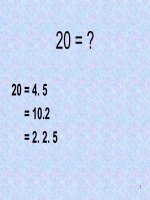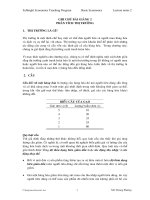Bài giảng Phân tích nước tiểu, cặn lắng nước tiểu
Bạn đang xem bản rút gọn của tài liệu. Xem và tải ngay bản đầy đủ của tài liệu tại đây (1.96 MB, 47 trang )
PHÂN TÍCH NƯỚC TIỂU,
CẶN LẮNG NƯỚC TIỂU
TS. Nguyễn Hữu Tùng
I. Introduction
1. History and importance
+ Uroscopy
Urinalysis
Past
+ Physical properties
Modern
+ Physical properties
+ Chemical analysis
+ Microscopic examination of
urine sediment
❖Urine Formation
❖Urine Composition
❖Urine Volume
II. Microscopic Examination of Urine
Urinary sediment: insoluble materials present in
the urine
+ RBCs
+ WBCs
+ Epithelial cells
+ Casts
+ Bacteria, yeast
+ Parasite
+ Mucus
+ Spermatozoa
+ Crystals
+ Artifacts
1. Macroscopic Screening
2. Preparation and Examination of the Urine Sediment
2.1. General procedures
+ Specimen preparation
+ Specimen volume: 10-15 mL
+ Centrifugation: 5 mins and RCF of 400
+ Volume of sediment examined: 20 uL (0.02 mL)
+ Examination of the sediment: both low (10x) and high
(40x) power
+ Reporting of the microscopic examination
-
Protocol
Result:
Casts: low-power field and average of 10 fields
RBCs, WBCs: high-power field and average of 10 fields
Epithelial cells, crystals, and other elements: (+), (++), (+++), (++++)
2.2. Sediment Examination Techniques
2.2.1. Sediment Stains
Safranin O
O-Toluidine
2.2.2. Microscopy
2.2.3. Sediment Constituents
1. Red Blood Cells
Clinical significance:
-
Glomerular membrane or vascular injury within the
genitourinary
Hematuria: trauma, acute infection or inflammation, and
coagulation disorders
2.2.3. Sediment Constituents
2. White Blood Cells
Clinical significance:
+ Nomal urine: < 5 leukocytes
+ Pyuria (increase in urinary WBCs): infection, inflammation in
genitourinary system
2.2.3. Sediment Constituents
3. Epithelial Cells
+ Three types of epithelial cells in urine:
- Squamous
- Transitional
- Renal tabular
Squamous epithelial cell
Transitional epithelial cell
Renal tabular epithelial cell









